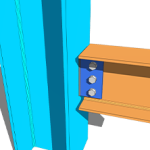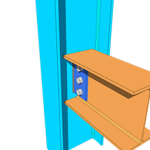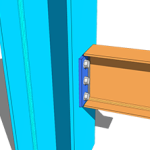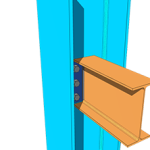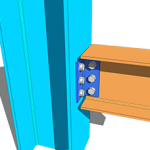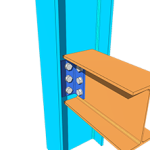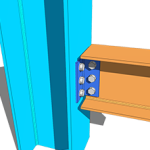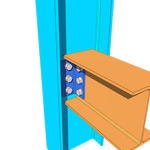Les connexions en acier répertoriées dans cet article sont conçues conformément à la norme australienne 4100:2020, Manuel de connexion de l'Institut australien de l'acier 1, et les guides de conception de l'Australian Steel Institute 1-5.
Poutre universelle à colonne universelle
Les connexions de poutres universelles à poteaux universels sont l'un des types de connexion les plus couramment utilisés dans la conception en acier. Le premier ensemble de connexions AS de SkyCiv sont toutes des connexions de poutre universelle à colonne universelle, où l'orientation de la colonne peut être changée en un support de bride ou un support d'âme. Actuellement, une seule connexion à un nœud peut être conçue à la fois. Lorsqu'il s'agit de connexions dos à dos, il est conseillé de prendre des hypothèses conservatrices sur le chemin de charge.
Connexions de cisaillement
Le type le plus basique d'une connexion en acier est une connexion de cisaillement. C'est un type de connexion qui ne traite que les charges de cisaillement uniquement, c'est-à-dire qu'aucune autre charge simultanée n'est présente. Pour la conception AS, les types de connexion de cisaillement suivants sont disponibles:
- Plaque latérale Web – Poutre à bride de colonne
- Plaque latérale Web – Ame poutre-poteau
- Plaque d'extrémité flexible – Poutre à bride de colonne
- Plaque d'extrémité flexible – Ame poutre-poteau
- Angle unique – Poutre à bride de colonne
- Angle unique – Ame poutre-poteau
- Angle double – Poutre à bride de colonne
- Angle double – Ame poutre-poteau
- Plaque latérale Web – Poutre à bride de colonne
- Plaque latérale Web – Ame poutre-poteau
- Plaque d'extrémité flexible – Poutre à bride de colonne
- Plaque d'extrémité flexible – Ame poutre-poteau
- Angle unique – Poutre à bride de colonne
- Angle unique – Ame poutre-poteau
- Angle double – Poutre à bride de colonne
- Angle double – Ame poutre-poteau
La conception des connexions de cisaillement ci-dessus était principalement basée sur les guides de conception ASI 3, 4, et 5. Les formules de référence ont été référencées à partir de l'AS4100:2020 manuel, tandis que le reste des calculs ou des critères ont été tirés du manuel de connexion ASI 1.
Coefficient de groupe de boulons
Pour plus de flexibilité sur la disposition des boulons et l'espacement des boulons, SkyCiv a adapté la méthode ICOR et l'analyse inélastique pour déterminer le coefficient de groupe de boulons C, qui sera ensuite utilisée pour calculer la résistance au cisaillement du groupe de boulons et la capacité portante des boulons.
La méthode du centre de rotation instantané (ICOR) utilise l'itération pour localiser l'IC du groupe de boulons. SkyCiv utilise son propre solveur pour ces itérations. L'emplacement du CI est inclus dans les calculs, mais les itérations ne sont pas affichées pour rendre le rapport plus concis et lisible.
L'équation utilisée pour calculer la force par boulon à l'aide de l'analyse inélastique est basée sur l'AISC Eq. (7-1) sur les pages 7-7 du manuel AISC 15e édition. L'équation est indiquée ci-dessous.
\(R = R_{ultime}(1-e^{-10\Delta })^{0.55}\)
Étant donné que la capacité du groupe de boulons a adapté la méthode AISC, les dispositions relatives à la détermination de l'excentricité de conception du boulon du groupe de boulons suivent également le tableau 10-9 de l'AISC 15e édition. Ceci est applicable sur la connexion AS Web Side Plate de SkyCiv. Pour les connexions à angle unique, les jambes NSL et OSL sur l'angle simple sont conçues avec une excentricité de charge. Pour les connexions à double angle, seule la jambe NSL est conçue avec excentricité puisque la jambe OSL est symétriquement équilibrée autour de la ligne de force. Pour les connexions de plaques d'extrémité flexibles, il n'y a pas non plus d'excentricité sur la charge, car la charge agit directement sur le centre du groupe de boulons. Tous ces groupes de boulons sans excentricité prendront alors le coefficient de boulon C comme le nombre total de boulons dans le groupe de boulons.
Types de luminaires
Pour les connexions d'angle, le type de fixation actuellement autorisé au niveau de la poutre et du support sont des types boulonnés. Le type soudé est encore en cours de développement et sera bientôt disponible.
Limitations détaillées
Les limitations détaillées ou les vérifications d'ajustement sur les connexions sont également ajoutées dans la nouvelle version de la conception de connexion AS. La plupart des limitations détaillées sont basées sur les guides de conception ASI 3-5, tandis que certains sont basés sur une approche d'ingénierie intuitive.
Un résultat de réussite ou d'échec est également ajouté pour la vérification des limitations détaillées dans l'onglet Analyse afin qu'il puisse être facilement identifié par l'utilisateur. Le rapport de calcul produit également un tableau, indiqué ci-dessous, pour la vérification des limites détaillées. Par ici, l'élément qui doit être modifié peut être facilement identifié.
Plus de types de connexion
La nouvelle version des connexions AS n'est que le début de cette conception australienne de connexion en acier. Si vous souhaitez ajouter plus de types de connexion, vous pouvez contacter Assistance SkyCiv.
Vous voulez essayer cette nouvelle fonctionnalité? Testez-le via notre Calculateur de conception d'assemblages en acier gratuit.

